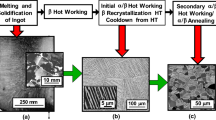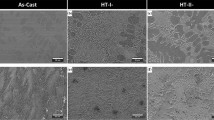Abstract
This paper generalizes the results of investigations of the effect of nitrogen on titanium alloys at temperatures of isothermal exposure of 800 – 1100°C and gas pressures of 105 – 10−1 Pa. As a result of nitration, a gas-saturated area appears on the surfaces of the alloys (in addition to the nitride area). Its qualitative and quantitative characteristics depend on the phase composition of the alloys. The gas-saturated area consists of two layers. For all the investigated alloys, the first layer (adjacent to the nitride area) can be described as the α-titanium structure stabilized with nitrogen. If the saturation temperature is lower than the temperature of the polymorphic transformation, then the structure of the second layer is identical to the alloy matrix. As a result of nitration in the (α+β)-β-region, this structure undergoes the β → α transformation and, for α- and pseudo-α-alloys, turns into an α-grain of smaller size but with higher etchability compared to the α-structure of the first layer. For (α+β)-alloys, this is mainly the α-phase (α-plates) in the β-transformed structure. For β-alloys, the morphology of the gas-saturated area does not depend on the saturation temperature and is identical to other structural types nitrated in the α-region.
Similar content being viewed by others
References
V. M. Fedirko and I. M. Pohrelyuk, “The role of temperature in the process of nitration of titanium alloys in a dynamic rarefied nitrogen atmosphere,”Fiz.-Khim. Mekh. Mater., No. 5, 76–79 (1990).
G. G. Maksimovich, V. N. Fedirko, and I. N. Pohrelyuk, “Kinetics of titanium alloy nitration at low pressure.”Fiz.-Khim. Mekh. Mater., No. 4, 80–83 (1986).
G. G. Maksimovich, V. N. Fedirko, and I. N. Pohrelyuk, “The rules of structural formation in nitrated layers of titanium alloys,”Metalloved. Term. Obrab. Met., No. 6, 11–14 (1986).
U. Zwicker,Titanium and Its Alloys [Russian translation], Metallurgiya, Moscow (1979).
A. I. Raichenko,Mathematical Theory of Diffusion in Applications [in Russian], Naukova Dumka, Kiev (1981).
E. N. Novikova, “Nitration of titanium alloys in pure nitrogen,” in:Titanium and Its Alloys [in Russian], Issue 3, Izd. Akad. Nauk SSSR. Moscow (1960), pp. 35–40.
D. P. Shashkov, A. V. Vinogradov, and V. N. Polokhov, “Kinetics of nitration and durability of titanium alloys,”Izv. Akad. Nauk SSSR, Ser. Metally, No. 6, 172–177 (1981).
L. F. Sokiryanskii, “Estimation of the depth of the gas-saturated layers in titanium alloys by the microhardness method,”Zavod. Lab. 35, No. 12, 1501–1503 (1969).
Additional information
Karpenko Physicomechanical Institute, Ukrainian Academy of Sciences, L'viv. Translated from Fiziko-Khimicheskaya Mekhanika Materialov, Vol. 29, No. 5, pp. 35–41, September–October, 1993.
Rights and permissions
About this article
Cite this article
Pohrelyuk, I.M., Fedirko, V.M. Morphology of nitrated layers in titanium alloys of different structural classes. Mater Sci 29, 467–472 (1994). https://doi.org/10.1007/BF00558766
Received:
Issue Date:
DOI: https://doi.org/10.1007/BF00558766




